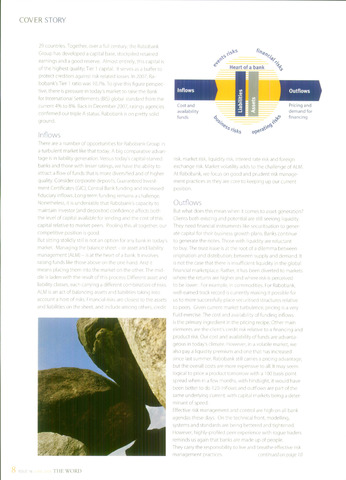COVER STORY
Inflows
Outflows
29 countries. Together, over a full century, the Rabobank
Group has developed a capital base, stockpiled retained
earnings and a good reserve. Almost entirely, this capital is
of the highest quality; Tier 1 capital. It serves as a buffer to
protect creditors against risk-related losses. In 2007, Ra-
bobank's Tier 1 ratio was 10.7%. To give this figure perspec-
tive, there is pressure in today's market to raise the Bank
for International Settlements (BIS) global Standard from the
current 4% to 8%. Back in December 2007, ratings agencies
confirmed our triple A status. Rabobank is on pretty solid
ground.
There are a number of opportunities for Rabobank Group in
a turbulent market like that today. A big comparative advan-
tage is in liability generation. Versus today's capital-starved
banks and those with lesser ratings, we have the ability to
attract a flow of funds that is more diversified and of higher
quality. Consider corporate deposits, Guaranteed Invest-
ment Certificates (GIC), Central Bankfunding and increased
fiduciary inflows. Long-term funding remains a challenge.
Nonetheless, it is undeniable that Rabobank's capacity to
maintain investor (and depositor) confidence affects both
the level of capital available for lending and the cost of this
capital relative to market peers. Pooling this all together, our
competitive position is good.
But sitting stolidly still is not an option for any bank in today's
market. Managing the balance sheet - or asset and liability
management (ALM) - is at the heart of a bank. It involves
raising funds like those above on the one hand. And it
means placing them into the market on the other. The mid-
dle is laden with the result of this process: Different asset and
liability classes, each carrying a different combination of risks.
ALM is an act of balancing assets and liabilities taking into
account a host of risks. Financial risks are closest to the assets
and liabilities on the sheet, and include among others, credit
fin.
Heart of a bank
\r
Cost and
availability
funds
Pricing and
demand for
\jf» financing
r'sks ope<a
risk, market risk, liquidity risk, interest rate risk and foreign
exchange risk. Market volatility adds to the challenge of ALM.
At Rabobank, we focus on good and prudent risk manage
ment practices as they are core to keeping up our current
position.
But what does this mean when it comes to asset generation?
Clients both existing and potential are still seeking liquidity.
They need financial instruments like securitisation to gener-
ate capital for their business growth plans. Banks continue
to generate the notes. Those with liquidity are reluctant
to buy. The trust issue is at the root of a dilemma between
origination and distribution; between supply and demand. It
is not the case that there is insufficiënt liquidity in the global
financial marketplace. Rather, it has been diverted to markets
where the returns are higher and where risk is perceived
to be lower. For example, in commodities. For Rabobank,
well-earned track record is currently making it possible for
us to more successfully place securitised structures relative
to peers. Given current market turbulence, pricing is a very
fluid exercise. The cost and availability of funding inflows
is the primary ingrediënt in the pricing recipe. Other main
elements are the client's credit risk relative to a financing and
product risk. Our cost and availability of funds are advanta-
geous in today's climate. However, in a volatile market, we
also pay a liquidity premium and one that has increased
since last summer. Rabobank still carries a pricing advantage,
but the overall costs are more expensive to all. It may seem
logical to price a product tomorrow with a 100 basis point
spread when in a few months, with hindsight, it would have
been better to do 120. Inflows and outflows are part of the
same underlying current, with capital markets being a deter
minant of speed.
Effective risk management and control are high on all bank
agendas these days. On the technical front, modelling,
systems and standards are being bettered and tightened.
However, highly-profiled peer experience with rogue traders
reminds us again that banks are made up of people.
They carry the responsibility to live and breathe effective risk
management practices. continuedon page 10
issue 16 THE WORD

